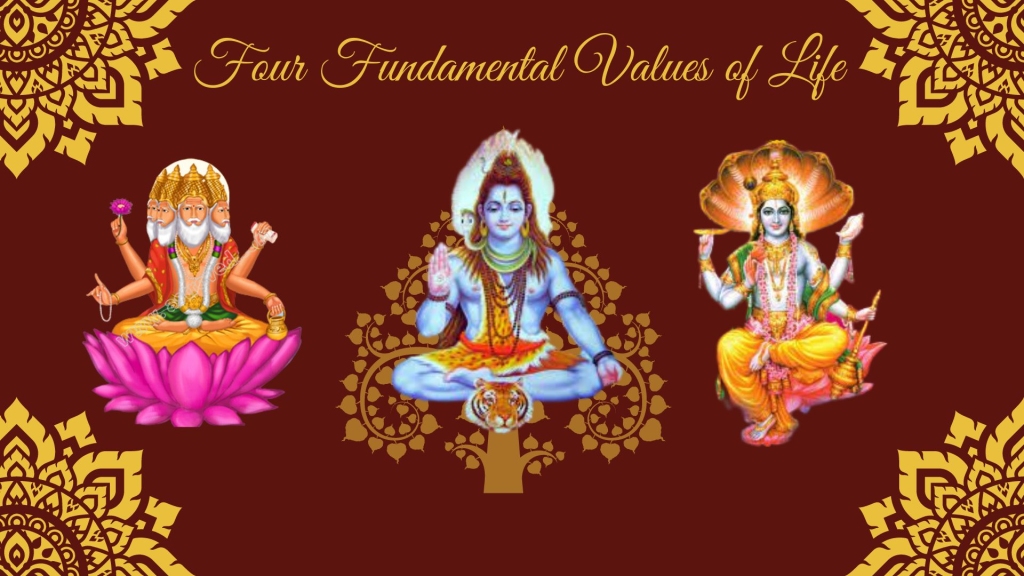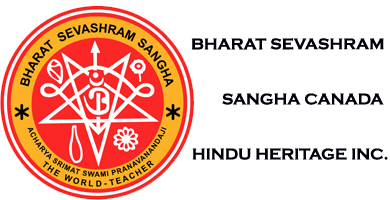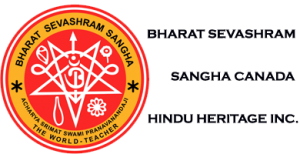
Hindu saints and sages proceed to the study of what man should be and what he should pursue, and so they discovered what is described in this Sanskrit work “Purushartha”. This word when translated means the ‘values of life’. To Western thinkers the ‘ultimate values’ referred to as Truth, Goodness and Beauty. But Purushartha means and connotes the aims and purposes of life or the Fundamental Aspirations of man.
The term Purushartha not only denotes what the objectives of life should be but it also means what the objectives of life are as the result of the psychological tendencies of the individual. These ‘Purusharthas’ are said to be four in number.The Agni Purana states clearly that (1) Dharma, (2) Artha, (3) Kaama and (4) Moksha are the four ‘Purusharthas’.
Dharmaartha-kaama-mokshashcha Purushartha Udaahrithah. This Purushartha classification is so well-established that it forms part of the Samkalpa which is recited by every Hindu supposedly before any ritual, ceremony or other religious or charitable act is begun. Dharma-arth-kaama-moksha- Chaturvigh-Purushaarth-Sidhyartham Karma Karishye. It is a well established principle that every ritual, ceremony or other religious act is performed for the purpose of enabling the worshiper or individual who performs it to realize these four Purusharthas of life. Whenever these are mentioned the order has always been that Dharma was the first, Artha was the second, Kama was the third, and the fourth and last was Moksha.
So we see the order in which they are referred to, has great significance and there is meaning behind it. A change in the order may alter the scope, content and relative importance of these four objects of life. Man longs, therefore, for pure joy, unalloyed, ever-lasting happiness, free from the least trace of misery and pain. Here on earth “we look before and after and pine for what is not real; our sincerest laughter is fraught with pain, and our sweetest songs are those that tell of saddest thoughts”.
Death, disease, old age, poverty and want bring in their train untold misery. The human heart is sick with hope deferrred, expectations blasted, ambition wrecked and desire unfulfilled. Dharma is the stability of society, the maintenance of social order, and the general welfare of mankind. And whatever conduces to the fulfillment of this purpose is called ‘dharma’.
Artha is the acquisition of wealth, is regarded as the primary purpose of life, as without it, human existence is impossible. One has to live before one can live well. Artha is the foundation upon which the whole structure of life has been built and all the other Purusharthas can be achieved only by the fulfillment of this primary purpose in life. Kaama means desires. Desires of varying degrees. It is from Dharma that Artha and Kaama result. Man recognises here that Artha and Kama satisfy the psychological tendencies of man and they form essentially the two fundamental aspirations of every individual.
Now the word Moksha literally, means deliverance, that is deliverance of the soul from bondage. Our great philosophers argue that, so long as the soul is imprisoned in the body, subject to the shackles of the human tendencies and inclinations and enmeshed in sordid matter, it will never be free from the taint of misery, pain and suffering of the three kinds, Adhi-bhautika, Adhi-atmika, and Adhi- daivika, bodily, mental and God-made, the tapa-traya . Moksha results from the extinction of false knowledge, which causes the extinction of lust and hate, which extinguish all karmas, which again results in the cessation of all birth, and the annulment of all sorrows.
When birth is at an end, sorrow ceases and Moksha is attained where the soul is free from the cycle of births and deaths. Hence according to our Hindu saints and sages, moksha is that perfect state of supreme bliss where there is the cessation of the effects of karma.

